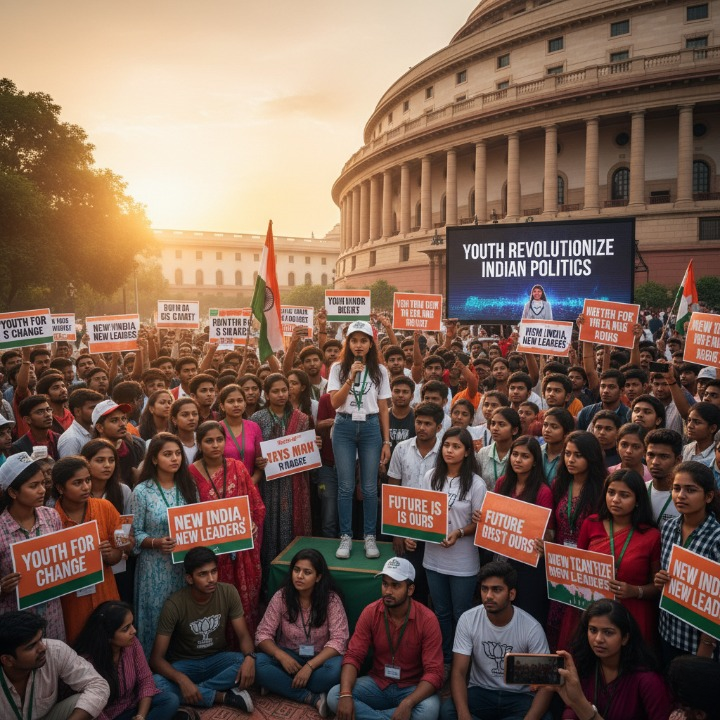India’s Young Population Poised to Reshape Governance with Fresh Perspectives and Bold Ideas
Key Highlights
- Demographic Strength: Over 50% of India’s population is under 30, creating an unprecedented opportunity for youth-driven political transformation.
- Challenges: Financial barriers, dynastic dominance, and lack of institutional support hinder youth participation in politics.
- Vision for Change: Grassroots mobilization, digital activism, and leadership training are paving the way for a youth revolution in governance.
Introduction
India, the world’s largest democracy, is at a crossroads. With more than half of its population under 30, the country has the potential to harness its demographic dividend to revolutionize governance. Yet, youth participation in politics remains disproportionately low, with established political hierarchies and systemic barriers discouraging active engagement. The question arises: Can India’s youth overcome these challenges to redefine its political future?
The Power of India’s Youth
1. A Dominant Voting Bloc
India’s young population wields significant electoral influence. According to the Election Commission of India, first-time voters accounted for nearly 14% of the electorate in the 2024 general elections, showcasing the role youth can play in shaping political narratives.
2. Grassroots Leadership
Young leaders are increasingly stepping up in local governance roles, from Panchayati Raj institutions to urban municipal bodies. These platforms provide vital experience and amplify the voices of those closest to community challenges.
3. Digital Activism
Social media has empowered youth to bypass traditional barriers, using platforms like Instagram, Twitter, and YouTube to advocate for change. Movements addressing climate action, women’s safety, and social justice highlight how technology enables young people to shape public discourse.
Barriers to Youth Participation
1. Financial Inequality
- Cost of Entry: Running an election campaign in India often requires significant financial backing, sidelining young aspirants from low-income backgrounds.
- Corporate Influence: Established parties benefit from corporate donations, further limiting opportunities for independent candidates.
2. Dynastic Dominance
- Lack of Meritocracy: Political dynasties dominate India’s political landscape, leaving little room for new entrants.
- Statistics: A 2024 ADR report revealed that 28% of MPs in the current Lok Sabha hail from political families.
3. Institutional Challenges
- Token Representation: Youth wings of major political parties, such as ABVP (BJP-affiliated) and NSUI (Congress-affiliated), often reflect broader party agendas rather than nurturing independent leadership.
Pathways for a Youth Revolution
1. Strengthening Grassroots Engagement
- Local Governance: Platforms like Panchayati Raj institutions and municipal councils offer accessible entry points for young leaders to address community-specific issues.
- Policy Focus: Encouraging debates on education, employment, and climate change can align politics with youth priorities.
2. Leveraging Digital Platforms
- Campaign Advocacy: Social media campaigns can galvanize support for youth-driven initiatives and challenge traditional hierarchies.
- Transparency Tools: Platforms like Know Your Candidate empower voters to evaluate leaders, encouraging a merit-based system.
3. Reforming Political Systems
- Reducing Campaign Costs: Public funding for elections can level the playing field for young candidates.
- Youth Quotas: Introducing age-based reservations in legislative bodies can ensure greater representation of young voices.
Conclusion
India’s youth have the energy, ideas, and vision to transform the country’s political landscape, but systemic barriers continue to hinder their participation. By addressing financial inequalities, reducing dynastic dominance, and fostering grassroots leadership, the nation can unlock the potential of its young population. As India navigates complex global and domestic challenges, a youth revolution in politics is not just desirable—it is necessary. The question remains: Will the system evolve to embrace the aspirations of its youngest citizens, or will the potential for change remain untapped? The future of Indian democracy may well depend on the answer.


Leave a Reply